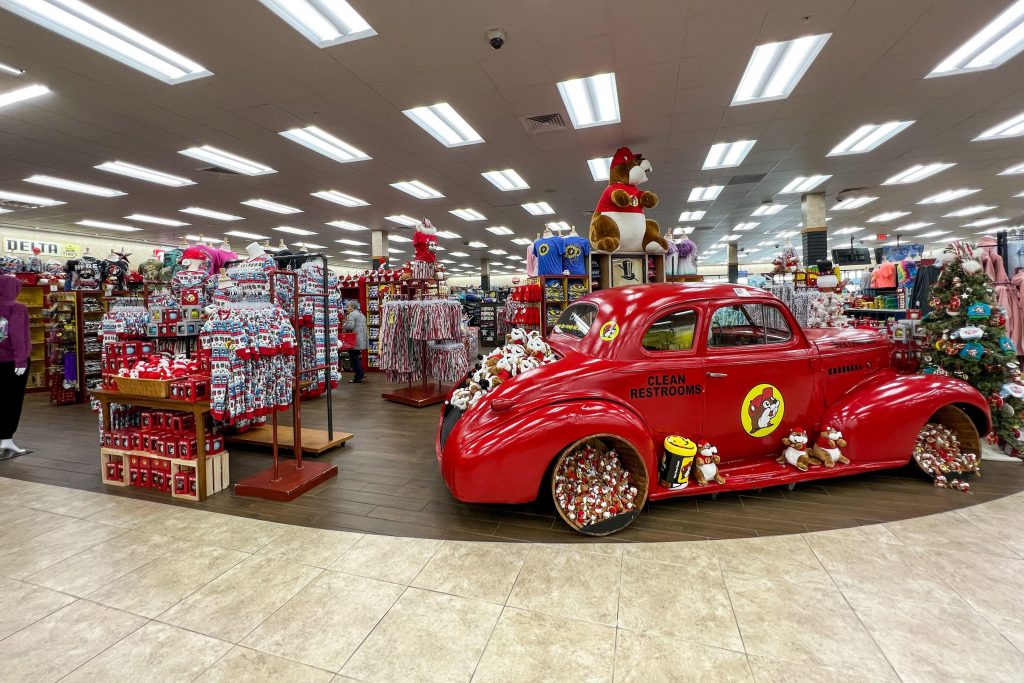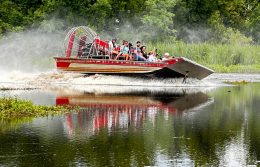Buc-ee’s: The Rise of a Texas Cultural Icon
Driving through Texas, you can’t miss Buc-ee’s. The mega gas station and convenience store is the largest roadside attraction you’ll pass during your road trip, with locations featuring dozens of pumps and square footage that dwarfs any other convenience store. Then there’s the humorous billboard advertising, which counts down the miles to the nearest Buc-ee’s, reminding you of the two best reasons to hold it until you can make your next pit stop at a Buc-ee’s. (No. 1, the state’s best roadside bathrooms, and No. 2, a photo op with Buc-ee the beaver who proudly welcomes visitors with outstretched paws.) Chances are you or someone in your car has been more excited about stopping at Buc-ee’s than wherever your final destination happens to be.
That’s because Buc-ee’s is more than a pit stop; it’s a cultural phenomenon. It has regularly been ranked the best convenience store with the best bathrooms with the best roadside food. Its iconic beaver mascot adorns thousands of bumpers, Texans show their pride by wearing Buc-ee’s T-shirts, and non-Texans make pilgrimages to the state just to stop at the famed convenience store. But how did a pit stop become one of the most recognizable symbols of Texas culture?
Here is the story of the growth of a gas station empire that’s poised to take over America.

A Family Tradition
If you trace the story of Buc-ee’s back to the beginning, you arrive at a time long before the age of the super-sized gas station. Harrisonburg, Louisiana, is a small town on the western bank of the Ouachita River, and during the early days of the 20th century, it was a crossroads for travelers, salespeople, and wanderers of all stripes. Arch and Mae Aplin opened a general mercantile store on the town’s main street, steps from the ferry that allowed travelers to cross the Ouachita. They stocked it with the kinds of products road-weary travelers needed, such as new shoes and shirts, medical supplies, and hearty lunch options. But there was something about the Aplin store that was different from the other stops along the route. Arch stocked local produce and sweet syrup made from their own sugarcane. The idea was they could stand out if they offered customers a little something extra — and it worked. According to Eric Benson’s history of Buc-ee’s in Texas Monthly, the Aplin’s store was known throughout the Deep South.
Flash-forward nearly 80 years, and Arch and Mae’s grandson Arch Aplin III was a freshly minted college graduate looking to make his way in the world. Although Aplin’s father did not take up the convenience store trade, Arch III had fond memories of visiting his grandparents’ store as a boy. When he found a vacant property near Lake Jackson, he thought he might open his own roadside convenience store. Like his grandparents, he wanted to offer something a little extra. He invested in sprucing up the interior design, and his store was larger than the average convenience store. Searching for a name, Arch III decided to use his childhood nickname — Bucky Beaver, or Buc-ee’s for short.

Eager Beavers
If you drove by the original Buc-ee’s in Lake Jackson, it’s unlikely you’d recognize in it the seeds of the next iconic Texas brand. But Arch III had ambitions to open more stores, and he and new partner Don Wasek began their expansion. They focused on reliably delivering the basics — clean restrooms, cheap ice — while always offering customers a little extra. In 1985, Buc-ee’s began adding an on-site kitchen. In 1989, they added clothing and fishing gear. In 1991, live music entered the mix. Each subsequent store was a little larger to make the experience more relaxed and roomier. By the 1990s, Aplin and Wasek had 20 stores throughout the state. They also made one crucial edit to the usual roadside model: 18-wheeler trucks were not allowed. Buc-ee’s wanted to brand its stores as a family experience.
But the growth of Buc-ee’s size and offerings only tells one side of the story. Its incredible success is just as bound up in the innovative, clever marketing that helped brand Buc-ee’s as more than a store. The adorable mascot, comedic billboards, an ample supply of Texas college-branded apparel, and beloved barbecue sandwiches helped establish a voice and identity that endeared Buc-ee’s to its Texan clientele. By 2003, Buc-ee’s had hit full stride. Its Luling store is arguably the first outlet that looks like the Buc-ee’s we have come to know and love today. It included branded t-shirts, Beaver, Nuggets, and a footprint of 17,000 square feet before nearly doubling that size by 2009. Buc-ee’s was no longer a pit stop — it had become the “Disney of convenience stores.”

An Empire Fed on BBQ
Today, a visit to a Buc-ee’s location is to experience the physical manifestation of the idea that “everything is bigger in Texas.” Buc-ee’s has more gas pumps, a larger soda fountain bar, more varieties of beef jerky and kolaches, and more barbecue than you can find at nearly any other gas station. There’s plenty of Buc-ee’s, college, and Texas-branded merch — but also home décor, in-store roasted nuts, and toys. The Buc-ee’s experience has become so renowned that people travel to Texas just to see what all the fuss is about. But don’t worry, non-Texans, Buc-ee’s may soon be coming to a roadside near you.
In 2019, Buc-ee’s opened its first out-of-state location in Alabama. Buc-ee’s is amid an all-out expansion throughout the south, with new locations in Florida, Georgia, and South Carolina. That’s not surprising. If there is one thing we’ve learned about the Aplin family over the years, they are always looking for ways to offer a little more.
While nothing will quite compare to the Buc-ee’s experience, there are plenty of other stop-worthy spots to explore on the road. Check out this ultimate guide to Texas highways for all the best roadside eats, attractions, and more!
© 2023 Texas Farm Bureau Insurance



